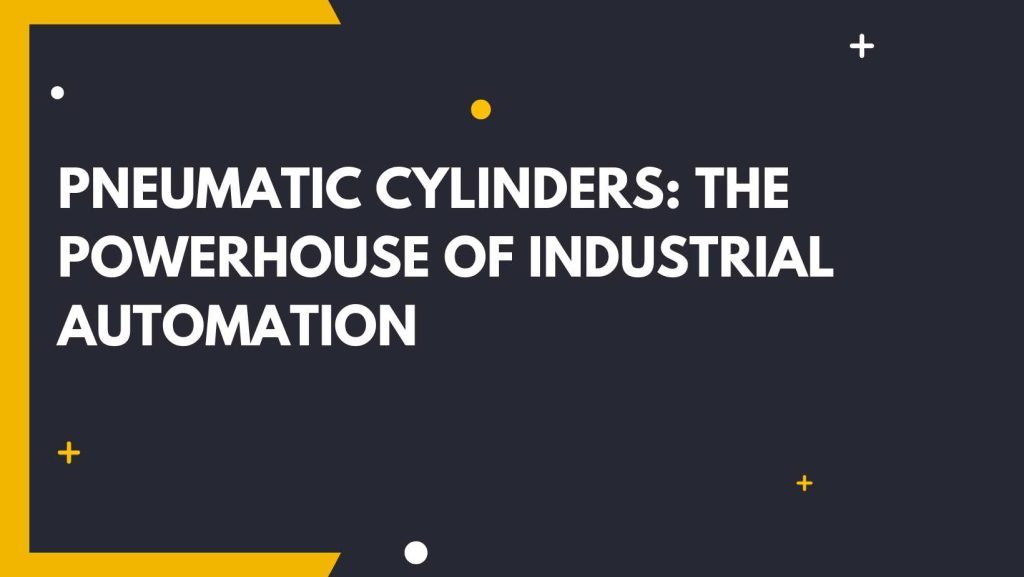Pneumatic Cylinders: The Powerhouse of Industrial Automation

Introduction
In the ever-evolving world of industrial automation, pneumatic cylinders stand out as the unsung heroes. These mechanical devices, driven by compressed air, play a pivotal role in various industries, from manufacturing to aerospace. In this article, we will dive deep into the world of pneumatic cylinders, exploring their types, applications, advantages, and much more.
What Are Pneumatic Cylinders?
Pneumatic cylinders are mechanical devices that utilize compressed air to create linear motion. They are often compared to hydraulic cylinders, which use pressurized fluid, but pneumatic cylinders have their unique advantages.
Types of Pneumatic Cylinders
There are several types of pneumatic cylinders, each tailored for specific applications. Understanding these types is crucial in choosing the right one for your industrial needs.
Single-Acting Cylinders (Piston)
- Explore the operation and applications of single-acting cylinders.
- Discuss how these cylinders utilize air pressure for one-sided motion.
Double-Acting Cylinders
- Highlight the advantages of double-acting cylinders.
- Explain how they use compressed air for two-sided motion.
Rotary Cylinders
- Introduce the concept of rotary cylinders.
- Describe their ability to create rotational motion in addition to linear motion.
Telescopic Cylinders
- Discuss the versatility of telescopic cylinders.
- Explore applications where their unique design is essential.
Applications of Pneumatic Cylinders
The widespread use of pneumatic cylinders extends to various industries and applications. Let’s delve into some of the key areas where these cylinders are indispensable.
Manufacturing
- Explore how pneumatic cylinders power conveyor systems and robotic arms.
- Discuss their role in shaping modern manufacturing processes.
Aerospace
- Highlight the importance of pneumatic cylinders in aircraft landing gear and control systems.
- Emphasize their reliability in critical aerospace applications.
Automotive
- Discuss how pneumatic cylinders assist in car braking systems and engine components.
- Explain their contribution to automotive safety and performance.
Material Handling
- Showcase the efficiency of pneumatic cylinders in lifting, pushing, and pulling heavy loads.
- Provide real-world examples of material handling equipment powered by these cylinders.
Advantages of Pneumatic Cylinders
Pneumatic cylinders offer a range of benefits that make them a preferred choice in many industrial settings.
Cost-Effective Automation
- Explain how pneumatic systems are often more budget-friendly than their hydraulic counterparts.
- Discuss the economic advantages of using compressed air for motion control.
Clean and Environmentally Friendly
- Highlight the cleanliness of pneumatic systems, as they don’t require hydraulic fluids.
- Emphasize their eco-friendly nature, reducing the risk of fluid leaks.
Quick and Precise
- Discuss the speed and precision with which pneumatic cylinders can operate.
- Explain their ability to provide rapid, responsive motion control.
Conclusion
Pneumatic cylinders are the unsung heroes of industrial automation, driving efficiency and reliability in various applications. Their cost-effectiveness, cleanliness, and precision make them a top choice for engineers and manufacturers. Embrace the power of pneumatic cylinders and witness the seamless motion control they bring to your industrial processes.
Frequently Asked Questions
What are the main differences between pneumatic and hydraulic cylinders?
- Explore the key distinctions in operation, fluid used, and applications.
Can pneumatic cylinders be used in hazardous environments?
- Discuss the safety considerations and suitability of pneumatic cylinders in such settings.
How do I choose the right pneumatic cylinder for my application?
- Provide guidance on factors like force, stroke length, and cylinder type to make the right choice.
Are there maintenance requirements for pneumatic cylinders?
- Explain the basics of cylinder maintenance to ensure longevity and performance.
What future innovations can we expect in pneumatic cylinder technology?
- Speculate on potential advancements and improvements in the world of pneumatic cylinders.







